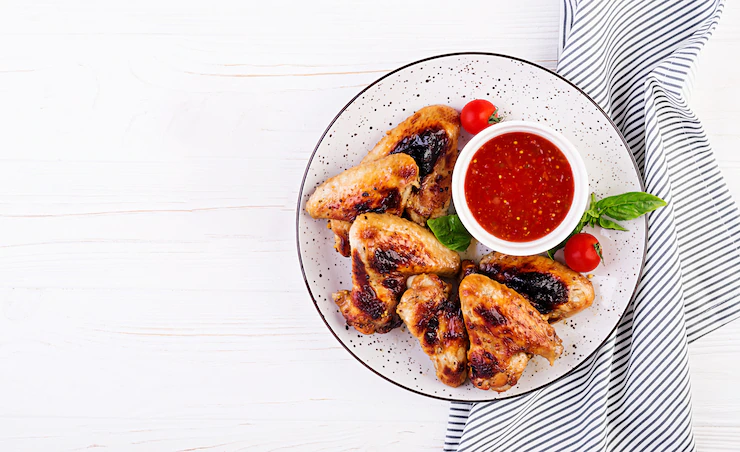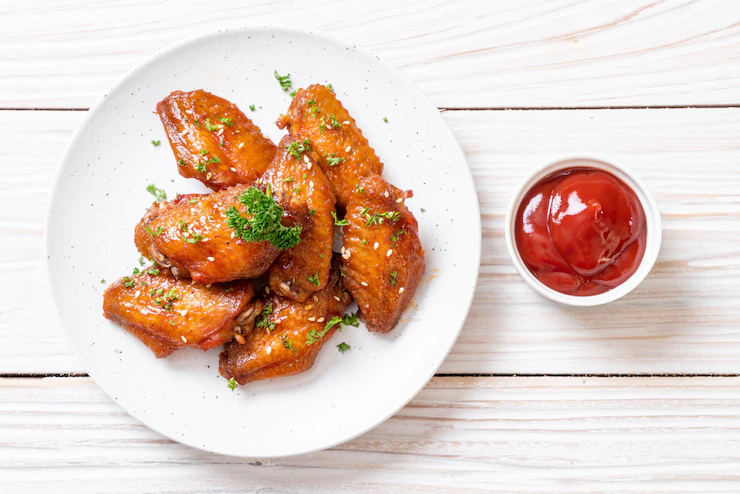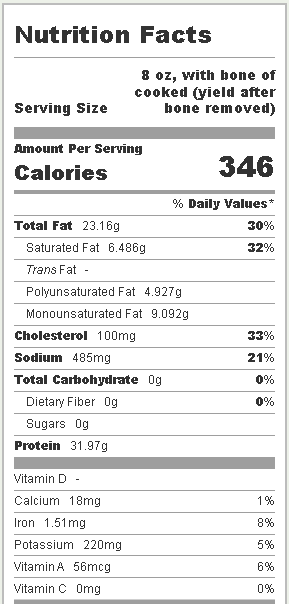You’re not alone if you’ve ever been curious about how many calories are in chicken wings. You’ve probably asked yourself the same question, too. In addition to the fact that chicken wings contain a lot of protein, they’re also high in calories. Just 8 ounces of chicken wings contain 346 calories and 23.16 grams fat. The same goes for chicken drumsticks. Fortunately, many healthy alternatives to chicken wings are lower in calories and fat.
You probably ate them skin-on if you’ve ever ordered chicken wings at a restaurant. This means that the skin adds 109 calories to the dish. But the meat inside is reasonably lean. As a result, chicken wings can still have substantial calories if you eat them with low-fat ranch or hot sauce.
Chicken Wings Nutrition Facts
What Are Chicken Wings?
Chicken wings have become synonymous with sports and drinking culture, but they’re always worth your time (and appetite). They’re simple to make, quick to prepare, high in protein, low in cost, and make a fun, filling finger meal for parties and evening dinners. Baked, fried, smoked, grilled, or cooked into soup are all options.
Chicken wings are a versatile, delicious ingredient worth learning more about, no matter how you consume them. There are three varieties of wings available at the market: entire wing, flat wing, and drumette wing (the latter being the part that looks like a mini-drumstick).
When you combine these two pieces, you can easily visualize a bird’s wing. The drumette is linked to the breast before the wing is split apart. The wingtip of chicken wings is also present but rarely included in the cut’s sectioned-off portions.
Two Parts of a Chicken Wing
When you stretch out a chicken wing and examine it from all sides, you’ll discover it’s divided into three sections: the drumette, wingette, and wingtip. Drumettes and wingettes are used in most chicken wings recipes, and you can utilize all of one or a combination of the two, depending on your preferences.
Drumette
The drumette, which resembles a miniature drumstick, is the meatier section of the wing. It’s the piece of the chicken that connects to the remainder of the bird, and it’s mostly dark meat, slightly juicier than the wingette.
Wingette
The wingette, sometimes called the flap, is the wing’s central area, made up of two horizontally running bones with meat in the middle. Because it is thinner, it quickly crisps when fried with thicker drumette pieces. (This is my favorite part of the wing!)Now that you know what chicken wing pieces are, it’s time to cut and separate them. You’ll need a razor-sharp knife and a meat-specific cutting board to make the cleanest cuts. (Avoid using wooden cutting boards while cooking fresh meat.)
Are Chicken Wings Healthy for a Diet?
Wings have unique qualities and benefits that should not be overlooked. Moderate eating of chicken wings provides several health benefits: sensible eating of chicken wings offers several health benefits: metabolic problems such as gout, arthritis, and diabetes can be treated with cooked chicken wings.
Chicken wings are indicated as part of a therapeutic diet for atherosclerosis, hypertension, stroke, and heart disease. The nutrients found in chicken products should be supplemented in the diets of the elderly. On the other hand, the number of chicken wings for a disposable serving piece should be discussed with your doctor.
- Recovers the body from injuries, fractures, and surgical procedures
- It helps to treat depression, neuritis, and neurological disorders
- Increases the blood hemoglobin
- Participates in the formation of new cells
- Raises the level of immunity
- Improves the condition of the skin, hair, and nails
- Blocks the formation of free radicals
- Prevents the development of cancer processes
- Improves reproductive function
- Normalizes brain activity
- Increases the growth of cartilage and connective tissue
- Regulates blood glucose levels
How to Get the Most Nutrition Out of a Chicken Wing?
You might think that to appreciate your classic wing truly, you’ll need a side of bleu cheese dressing and that each fried bite will need to be coated in a sticky hot sauce. However, you can get the most nutrients from chicken wings by steaming, oven-roasting, or grilling them to their maximum potential.
EU Poultry also recommends removing the skin to make your chicken wings as healthful as possible if you want to cut down on fat even further. Nothing beats a friendly, old-fashioned chicken wing for taste and nutrition. Whatever way you want to eat your chicken wings, you’ll get a lot of bang for your buck from that plate of chicken goodness.
Each bite’s nutrients may also aid in relieving the symptoms of arthritis, diabetes, and gout, treating depression, improving skin health, boosting immunity, and more (via EU Poultry). Give this cuisine another chance- you won’t be disappointed if you haven’t had it in a while.
Can You Overeat Chicken?
Chicken is a popular dish in many households, and with good reason! Chicken can be used in almost any meal, whether coated in breadcrumbs, cheese, and sauce for a classic parmesan or grilled with fresh lime juice and garlic for a fajita.
It’s a high-quality protein source that’s also reasonably affordable and adaptable. It’s a high-quality protein source that’s also reasonably affordable and adaptable. However, if you eat chicken more often than you’d like, you could wonder what’s going on with your body.
- Calcium and vitamin D tend to take center stage for bone health. On the other hand, protein is an essential component for avoiding osteoporosis and maintaining a healthy and robust skeleton.
- Including protein sources, like chicken, at mealtime can help you feel more satisfied, which may help you resist the after-dinner munchies.
- Choline is a vitamin found in chicken that helps with memory and other brain processes. According to research, those who drink more choline do better on memory tests than people who do not consume enough of this nutrient.
- Chicken includes tryptophan, an amino acid that helps raise serotonin levels (the “feel-good” hormone). Low serotonin levels have been related to depression. Therefore eating chicken or other foods that boost serotonin levels may help you feel better.
- If you have iron-deficiency anemia, you may feel exhausted, even after a good night’s sleep. You’ll get a boost of iron from dark-meat chicken, which can help you restore your iron levels and overcome your deficit.
Conclusion
Consider a ketogenic or low-carb diet if you don’t feel like eating wings. Chicken wings are considered a healthy tailgate food, containing around 6 grams of protein per wing, making them nutritious. Wings without breading are usually keto-friendly; the same goes for ketogenic and low-carb diets.
If you follow these guidelines, you’ll be fine eating chicken wings on either diet. Regarding portion size, three ounces of buffalo chicken wings are the optimal portion size. According to nutritionists, this portion is ideal, and anything more significant than that can double or triple the calories.
Buffalo chicken wings are exceptionally high in saturated fat, sodium, and calories. Even when you’re not hungry, a full-sized portion can contain more than 1000 calories. So, make sure you’re only eating three ounces of chicken wings.


